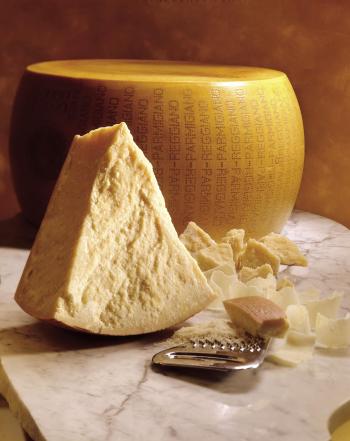Parmigiano Reggiano
- Producer
- Various
- Country
- Italy
- Region
- Emilia Romagna
- Size
- 16-18 ins diameter, 10 ins high
- Weight
- 86 lbs
- Website
- parmigianoreggiano.us
- Milk
- Cow
- Treatment
- Raw
- Classification
- Hard
- Rennet
- Animal
- Rind
- Natural
- Style
- Grana / Grating cheese

Considered by some to be the greatest cheese on earth, Parmigiano Reggiano is a magnificent cheese by any standard. According to EU law, it is also the only cheese that qualifies to use the name 'Parmesan,' as opposed to other hard grating cheeses made outside Europe. There are hundreds of active producers, including many dairies and factories known as caselli. These are regulated by a "Consorzio" (consortium) that upholds the protected name standards, grades cheeses, and handles worldwide advertising and marketing.
The protected name designation states that Parmigiano Reggiano can only be made from milk produced by cows fed with a certain percentage of fresh grass and hay within a geographic zone, according to strict regulations. Although the name controlled version is just about 800 years old, the recipe is attributed to Benedictine monks working in the Po Valley in around 1200.
For production of Parmigiano Reggiano, a combination of skimmed evening milk is combined with whole morning milk and heated. The curd is coagulated using animal rennet and after cutting and reheating to expel the whey, the curds are packed into very large molds and a simple weight is placed on top to ease out more whey. Cheeses are flipped and re-weighted several more times before being allowed to sit overnight. Prior to finally being unmolded, a plastic matrix, dotted with small blunt needles and a plaque with the identifying number of the cheese producer, is inserted between the cheese and the mold. This matrix spells out the words Parmigiano Reggiano so that when the mold is tightened around the cheese, all the information is gently pressed into the rind. Wheels are placed in a brine solution for up to one month before being transferred to maturing cellars.
Parmigiano's different stages of maturity are recognized by aging seals given at 18 months, 24 months and 30 months. Parmigiano Reggiano received DOP status according to the Stresa Convention that was signed in 1955. Its European PDO status was awarded in 1996.
Tasting Notes
Considering the number of dairies producing this cheese, it's no surprise that Parmigiano Reggiano varies depending on season and location. A summer cheese might yield more grassy and herbaceous notes, while other versions have more lactic or buttery characteristics, and others have nutty aromas. Age matters, too; younger wheels tend to be fudgier, while paste becomes more crumbly and slightly drier, studded with crunchy amino acid crystals, as maturation continues. Age also results in a concentration of flavor and aroma, and a deepening of the cheese's characteristic umami.
Pairings
Parmigiano Reggiano can be used in endless cooking preparations and served in many ways, but the most typical pairing is with honey or a balsamic vinegar from Modena.



